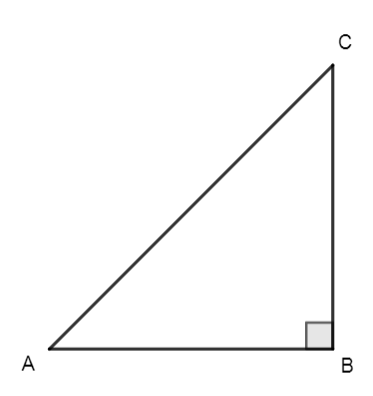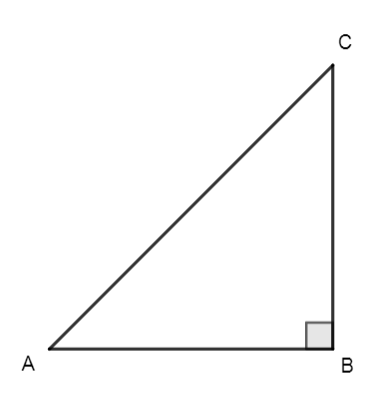
The value of $\sin A$ or $\cos A$ never exceeds the value_____.
Answer
568.2k+ views
Hint: First use the trigonometric ratio to find the ratio of sine and cosine in terms of perpendicular, base and hypotenuse. Then use the Pythagoras theorem to get the result that the Hypotenuse is the longest side of the right triangle. Use this result to get the desired result.
Complete step-by-step answer:
For any right angle triangle, which is right-angled at angle B. Then for the angle A, the base of the triangle is AB, perpendicular to the triangle is BC, and the hypotenuse of the triangle is AC. The figure of the triangle is shown.

Using the trigonometric ratios, we know that the sine of the angle A is the ratio of the perpendicular and the hypotenuse and cosine is the ratio of the base and the hypotenuse. That is,
$\sin A = \dfrac{{{\text{Perpendicular}}}}{{{\text{Hypotenuse}}}}$
$\cos A = \dfrac{{{\text{Base}}}}{{{\text{Hypotenuse}}}}$
Using the Pythagoras theorem, the square of the hypotenuse of the triangle is equal to the sum of the square of the perpendicular and the base of the triangle.
${\left( {{\text{Hypotenuse}}} \right)^2} = {\left( {{\text{Perpendicular}}} \right)^2} + {\left( {{\text{Base}}} \right)^2}$
Then we can conclude that:
${\left( {{\text{Hypotenuse}}} \right)^2} > {\left( {{\text{Perpendicular}}} \right)^2}$and${\left( {{\text{Hypotenuse}}} \right)^2} > {\left( {{\text{Base}}} \right)^2}$
$ \Rightarrow {\text{Hypotenuse}} > {\text{Perpendicular}}$ and ${\text{Hypotenuse}} > {\text{Base}}$
So, we get the conclusion that the hypotenuse of the right triangle is the longest side of the triangle.
Thus, the ratio of sine and cosine is always less than 1.
So, the value of $\sin A$ or $\cos A$ never exceeds the value 1.
Note: While using the Pythagoras theorem, remember that the perpendicular and the base of the triangle are changed with the angle. We have used angle A for finding the ratio of the sine and cosine. In case, if we use the angle C, then the perpendicular is taken as AB and base is taken as BC.

Complete step-by-step answer:
For any right angle triangle, which is right-angled at angle B. Then for the angle A, the base of the triangle is AB, perpendicular to the triangle is BC, and the hypotenuse of the triangle is AC. The figure of the triangle is shown.

Using the trigonometric ratios, we know that the sine of the angle A is the ratio of the perpendicular and the hypotenuse and cosine is the ratio of the base and the hypotenuse. That is,
$\sin A = \dfrac{{{\text{Perpendicular}}}}{{{\text{Hypotenuse}}}}$
$\cos A = \dfrac{{{\text{Base}}}}{{{\text{Hypotenuse}}}}$
Using the Pythagoras theorem, the square of the hypotenuse of the triangle is equal to the sum of the square of the perpendicular and the base of the triangle.
${\left( {{\text{Hypotenuse}}} \right)^2} = {\left( {{\text{Perpendicular}}} \right)^2} + {\left( {{\text{Base}}} \right)^2}$
Then we can conclude that:
${\left( {{\text{Hypotenuse}}} \right)^2} > {\left( {{\text{Perpendicular}}} \right)^2}$and${\left( {{\text{Hypotenuse}}} \right)^2} > {\left( {{\text{Base}}} \right)^2}$
$ \Rightarrow {\text{Hypotenuse}} > {\text{Perpendicular}}$ and ${\text{Hypotenuse}} > {\text{Base}}$
So, we get the conclusion that the hypotenuse of the right triangle is the longest side of the triangle.
Thus, the ratio of sine and cosine is always less than 1.
So, the value of $\sin A$ or $\cos A$ never exceeds the value 1.
Note: While using the Pythagoras theorem, remember that the perpendicular and the base of the triangle are changed with the angle. We have used angle A for finding the ratio of the sine and cosine. In case, if we use the angle C, then the perpendicular is taken as AB and base is taken as BC.

Recently Updated Pages
Master Class 10 General Knowledge: Engaging Questions & Answers for Success

Master Class 10 Computer Science: Engaging Questions & Answers for Success

Master Class 10 English: Engaging Questions & Answers for Success

Master Class 10 Social Science: Engaging Questions & Answers for Success

Master Class 10 Maths: Engaging Questions & Answers for Success

Master Class 10 Science: Engaging Questions & Answers for Success

Trending doubts
The shortest day of the year in India

Why is there a time difference of about 5 hours between class 10 social science CBSE

Write a letter to the principal requesting him to grant class 10 english CBSE

What is the median of the first 10 natural numbers class 10 maths CBSE

The Equation xxx + 2 is Satisfied when x is Equal to Class 10 Maths

State and prove converse of BPT Basic Proportionality class 10 maths CBSE




